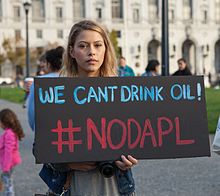Standing Rock Indian Reservation straddles the border between North Dakota and South Dakota. It is the country's sixth largest reservation at 3,750 square miles (9,250 km2). Population was 8,217 as of the 2010 census, from various tribes of the Sioux.
Understand
[edit]As for most tribes, the history of the Sioux over the last few centuries is a sad and complex tale with some battles fought, several treaties made, more-or-less all of them broken by the whites, and Indian land repeatedly reduced. The Sioux on this reservation are descendants of those who defeated Custer at Little Bighorn and were massacred at Wounded Knee.
See Indigenous cultures of North America for more general discussion of native cultures.
DAPL protests
[edit]
In 2016, Standing Rock made news in a big way: that year, plans to run the Dakota Access Pipeline (DAPL) near the reservation were met with massive protests against what was seen as both a threat to the local water supply and, according to tribal elders, a desecration of sacred burial grounds. While legal challenges to the pipeline slowly worked their way through the courts, the reservation became the site of several huge semi-permanent camps of occupying protesters who aimed to block the pipeline's construction. The local Sioux by no means stood alone: over 100 other tribes from across the U.S. and Canada, along with some in South America and even New Zealand Maori, declared their support and in some cases sent people to the camps. There were also many non-Indian allies involved, including a number of celebrities.
While the Obama administration decided in its waning days against granting an easement for the pipeline, the protesters' victory was short-lived: almost immediately after his inauguration, Donald Trump directed the U.S. Army Corps of Engineers to reverse his predecessor's decision, and construction of the pipeline (and the dismantling of the protest camps) proceeded quickly thereafter. The first oil began flowing through the DAPL in June 2017.
Orientation
[edit]There are no actual cities within Standing Rock. The main settlements are Fort Yates, Cannonball and McLaughlin. Fort Yates is the administrative center with all the tribal offices and Sitting Bull College.
Get in
[edit]A number of highways pass through the region. McLaughlin is at the intersection of US 12 running roughly east-west and SD 63 north-south. Crossing the border, SD 63 becomes ND 6 which leads to ND 24. ND 24 goes near Fort Yates and Cannonball then leads north toward Bismarck.
Get around
[edit]- Standing Rock Public Transit, 9299 Highway 24, Fort Yates, ☏ +1 701 854-8090, fax: +1 701 854-3061. Dispatch: M-F 7:30AM- 4:30PM. Reservations are required 24 hours in advance and must be made by calling during dispatch hours.
See
[edit]
- 1 Sitting Bull Visitor Center (On hill behind Sitting Bull College in Fort Yates), ☏ +1 701 854-8125, jennifer.martel@sittingbull.edu. M-F 8AM-4:30PM.
- Standing Rock Museum of Natural History, 1341 92nd St.
Do
[edit]Eat
[edit]- The Rock Pizza and Grill, 306 Sitting Bull Street, Fort Yates ND, ☏ +1 701 854-7625. M-F 8AM–10PM; Sa 9AM-10PM; Su 10AM- 8PM.
- Hot Stuff Pizza, 302 2nd Ave, Fort Yates, toll-free: +1-800-648-6227.
- White Buffalo Foods, 112 Yates St, Fort Yates, ☏ +1 701 854-3423. M-F 7:30AM-7PM; Sa 9AM-5PM; Su 9AM-4PM. Grocery store.
Drink
[edit]- My Auntie's Coffee & More, 100 Standing Rock Road, Fort Yates, ☏ +1 701 854-2300. M-F 7:30AM-4:30PM.
Sleep
[edit]- 1 Prairie Knights Casino & Resort, 7932 Hwy 24, Fort Yates, ☏ +1 701 854-7777, toll-free: +1-800-425-8277.
- Grand River Casino & Resort, Hwy 12 (4 mi (6.4 km) west of Mobridge, SD), toll-free: +1-800-475-3321.
Connect
[edit]- U.S Post Office, Fort Yates ND, 110 S. River Rd, Fort Yates, ☏ +1 701 854-7412.


